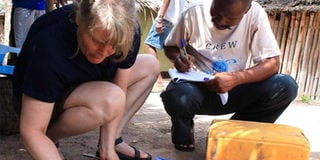Protecting endangered sea turtles in Watamu coastline

The Local Ocean Conservation team checking the condition of a rescued turtle in Watamu. PHOTO | JAN FOX
What you need to know:
- I was with Kahindi Changawa and his team from the Local Ocean Conservation (LOC), a private, not-for-profit organisation committed to the protection of Kenya’s marine environment.
- Hundreds of turtles are rescued every year through LOC’s bycatch release programme, and in April they rescued their 17,000th turtle.
- Kahindi lifted the turtle out of the bucket and placed it gently into a harness to be weighed. It was then measured, photographed and tagged, and assessed to be healthy enough for immediate release.
A young Hawksbill turtle was presented to us in an old green bucket, by a group of fishermen in the north of Watamu. The turtle had been caught up in their net as “bycatch”— when non-target species are accidentally captured in fishing gear.
I was with Kahindi Changawa and his team from the Local Ocean Conservation (LOC), a private, not-for-profit organisation committed to the protection of Kenya’s marine environment.
Hundreds of turtles are rescued every year through LOC’s bycatch release programme, and in April they rescued their 17,000th turtle.
Kahindi lifted the turtle out of the bucket and placed it gently into a harness to be weighed. It was then measured, photographed and tagged, and assessed to be healthy enough for immediate release.
After the fishermen were paid a small amount to help them cover the cost of any damage to their fishing gear, we put the turtle in a large padded box and headed to a spot where it could be safely released back into the ocean. Once on the beach, it flapped its flippers wildly and propelled itself into the surf.
Other turtles rescued are not so lucky, because they are sick or injured when they are found. Instead of being released straight away, these turtles are transported back to LOC’s Turtle Rehabilitation Centre in Watamu, where they can be monitored and nursed back to health.
Before the rescue operation, we were given a tour of the centre by Laura Jessop, who has been volunteering with LOC for four months. Here we met Hope, another Hawksbill turtle who was recovering from serious flipper injuries, likely to have been caused by an eel.
The centre also has a quarantine area to treat turtles with Fibropapillomatosis (FP) — a condition specific to sea turtles characterised by benign but debilitating epithelial tumours. Eight turtles have so far been treated here for FP this year.
FEEDING GROUNDS
As we explored the centre, Laura told us a bit about the history of LOC. The Watamu and Malindi Marine National Parks and Reserves are important residing and feeding grounds for five species of sea turtles, all of which are either critically endangered, endangered or vulnerable on the IUCN Red List. The stretch of beach within the Watamu Marine Park is a key nesting site for two species in particular, Green turtles and Olive Ridley turtles. To protect the female turtles and their nests, a group of volunteers established Watamu Turtle Watch in 1997.
The initiative expanded over the years in recognition of the need for wider community involvement in marine conservation in the area, and now Local Ocean runs several programmes.
In addition to the rehabilitation centre, the bycatch release and nest monitoring and protection programmes, LOC staff and volunteers conduct data collection and research, conservation awareness and education, community outreach, anti-poaching, mangrove restoration and beach clean-up initiatives.
Through their environmental education programme, they work with 30 schools in the area, providing the opportunity for children to learn about the importance of protecting their local marine environments. Those who show a particular interest in this field are nominated for LOC’s marine scouts programme, and become ambassadors of the environment within their communities.
Every Saturday, the scouts visit the LOC centre, and take part in the wide range of activities on offer. After visiting Hope in the Turtle Rehabilitation Centre, Laura showed us around the lush Marine Green Garden — a demonstration area for income generating activities and conservation ideas.
We were led to a tree nursery with mangrove seedlings, along a winding path lined with recycled glass bottles, and a large turtle fashioned from plastic bottle caps and flip-flops collected from the beaches. On the edge of the garden are large stacks of turtle skulls and shells, collected over the years by anti-poaching patrols.
The consumption of turtle meat and eggs is deeply engrained in coastal Kenyan culture, and the meat also fetches a high price on the black market.
Poaching is just one of many threats facing the turtles, though, and these are described in detail on large information boards across the LOC centre. The development of sea walls, houses, hotels and restaurants along the beaches, has led to the destruction of natural coastal defences, and important habitats for nesting turtles. Increasing levels of pollution, particularly of harmful plastics, overfishing, irresponsible tourism and the warming of the ocean through climate change, are all serious threats to the turtles and the coastal ecosystem.
The work of Local Ocean Conservation, then, is vital for the protection of Kenya’s sea turtles and their habitats.
To support their work, and to learn more about the turtles, you can visit their centre along Turtle Bay Road in Watamu, check out their website, www.watamuturtles.com, or follow their daily activities on Facebook (Local Ocean Trust: Watamu Turtle Watch) or on Instagram, @localoceantrust.
The centre is open to visitors between 2 pm and 4 pm on Monday, between 9.30am and noon and between 2 pm and 4 pm on Tuesday to Friday, and between 9.30 am noon on Saturday.
Jan Fox is a director at iDC





